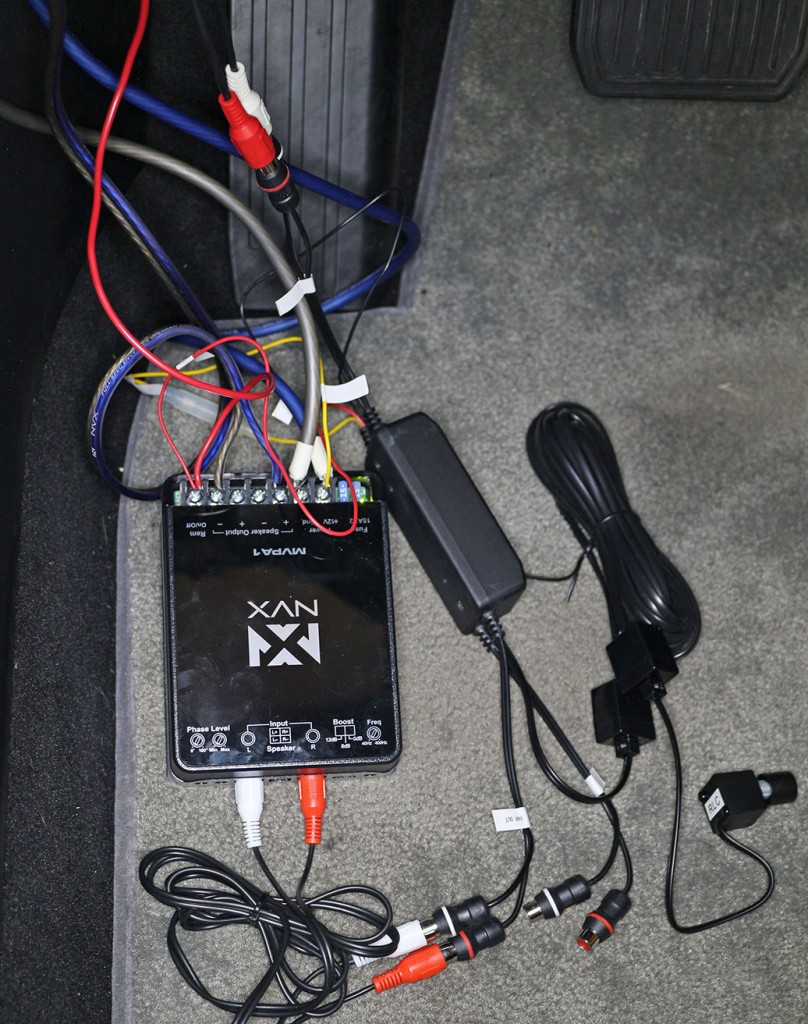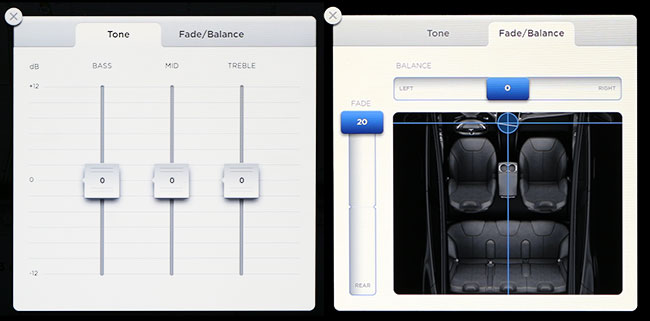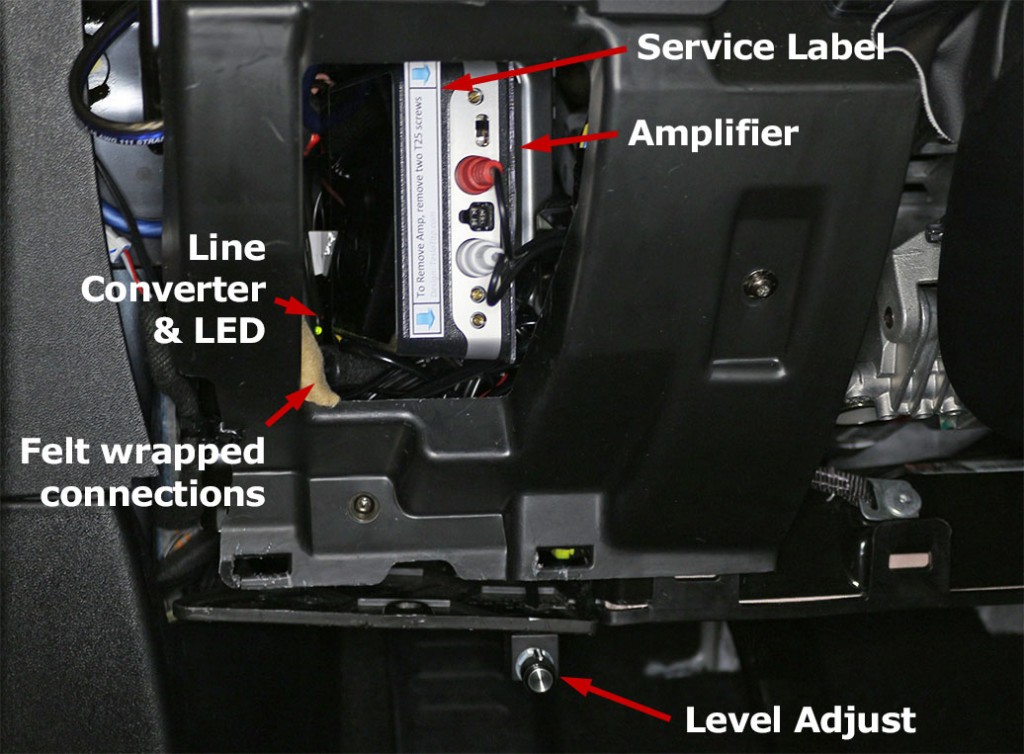Before installing the amp in its final spot, it was relatively easy to test, adjust and confirm proper operation with the amp sitting on the floor. Keep the amp’s plastic terminal block cover removed so you can see the status LEDs
Setup
For testing and making adjustments, ideally, you’ll need audio test sounds. I used recorded sounds from the Alan Parsons Professional Audio Test CD. This disk has many sound test tracks that are ideal for setting up the system. Unfortunately, it appears this CD is out of print, although I’m sure there are others available that will work. Precision Test Signals CD on Amazon appears to have most of the needed tests. The audio tracks you’ll need include:
- A range of fixed frequencies from 20 Hz to 200 Hz
- Frequency sweep from 200 Hz to 20 Hz or similar
- Music track you like with deep bass
You’ll need to transfer the needed sounds or the entire test CD to a USB stick. I strongly recommend you use a lossless format such as WAV, FLAC, or AIFF. We really don’t care about the space used by the files as it is only for testing. You can simply copy the files from the CD to your USB stick using a PC or Mac – there is no need to convert them.
If you don’t have audio test sounds, it’s still possible to get a rough adjustment using just a music track with heavy bass. With an external level control, you can also tweak the level later on.
If you’re using a speaker in the trunk well, close up the well as you expect it to be when the project is complete. Close the liftgate, all windows, doors, and the sunroof.
If using a wired remote level control, set the control to the center position. Set the Tesla volume level to 8. On the Tesla audio screen, open the Tone screen and set all the settings to the center zero mark. On the Fade/Balance screen, shift the levels to the center front (no rear speaker volume).
Depending on the amplifier, there are various adjustments. On the NVPA1 amp, we set the phase to 0 degrees, level to Min, Boost to 0 dB, and center the Frequency cutoff control.
Testing
With the car audio first turned on (i.e. you’re in the driver’s seat), the NVX amplifier will show a red LED next to the switched power lead. After about five seconds, this LED goes out, and a green LED appears next to the always-on power side. If this doesn’t occur, you may have a wiring error or one of the power leads is not providing 12v. Check the voltage and ground with a meter to identify which line might be at fault. For always-on power, you might confirm you connected the add-a-fuse to the right fuse location. For switched power with a basic audio system, it is possible that Tesla did not include the F8 fuse for this circuit, although it was present in my car. Unfortunately, fuse box 1 is very hard to get to where F8 resides. Use our Fuse locator guide.
If using the JL line converter, a green LED on the top of the box should be illuminated. If not, check that the yellow lead is connected to always-on power, the red lead to switched power, and the black ground wire is connected to the ground.
Now we’ll test that the audio paths are working. Play a 50 Hz test signal (or music with known very low bass). On the amp, adjust the level control to a point where you can confirm the sub-woofer is getting the audio signal. If you are not getting a signal, you need to figure out where the signal may be blocked or failing. Never leave the amp’s level control at maximum to avoid blowing the speaker and your eardrums when you suddenly fix it! Some of the things to check for:
- Remove the RCA connectors from the amp. Use a secondary music source such as an iPod, CD player, or any device that can produce some sounds through RCA line outputs. Connect the outputs to the amp and check if you can hear anything from the sub-woofer. If so, it will confirm the amplifier and speaker are working. If this fails, check the speaker connections on both ends. Note that the amp has four speaker terminals, but only the outside two are used (+ connection near the ground terminal, and the – connection next to the switch 12V power terminal).
- With the amp and speaker confirmed working, from the JL line converter, switch from the variable line outputs to the fixed-line outputs. Using the test tone, see if you now have audio. If the variable line output is dead, confirm it is securely connected (via the phone jacks) and the level control is set to the halfway position, and try it again. My first line converter had a dead variable line output and I had to replace the unit.
- If still no sound, remove all the RCA connections from the JL line converter. Connect one RCA jack from the Tesla audio connector directly to the amp. See if that works. If so, the line converter may be a problem.
- If it still doesn’t work, switch to the other RCA connector as a test. Check the wiring and confirm you’ve wired the RCA plugs to the correct Tesla wires or connector pins.
Adjustments
The Ultra High Fidelity sound system’s Sub-woofer line out provides the best source for your sub-woofer amp. On basic systems, the left/right line-level and speaker outputs have an electrical peak at 100 Hz and drop off as you go to lower frequencies. There is almost no audio below 30 Hz. This is a good design by Tesla to not overload the existing speakers at frequencies they can’t handle but leaves us without a perfect source on basic sound systems for the sub-woofer. Still, quite a bit of low-end bass is available to significantly improve the overall sound.
-
- I adjusted the amp’s frequency cut-off and level controls using the 63 Hz, 80 Hz, and 100 Hz test tones to get an even sounding level and confirmed the sub’s sound at lower frequencies. If you have a sound meter, this can be calibrated accurately. Cars with Ultra High Fidelity sound using the sub-line level output will handle the lowest frequencies without a problem. With basic audio, the line outputs and left/right speaker outputs have a sharper roll-off below 50 Hz, so you may want to compensate the level slightly to counteract this effect. An audio purist might want to include a bass equalizer to obtain a flatter bottom-end frequency response, although I don’t think this is really necessary.
- The amp I used also has a phase adjustment. Its purpose is to improve the crossover between the sub-woofer and the existing speakers. To check and adjust, use a 250 Hz to 20 Hz sweep (Alan Parson test track 42, has four sweeps, where the 3rd sweep is 250 to 125 Hz, and the 4th sweep is the more important 125 to 20 Hz range). Adjust the phase to reduce or eliminate any frequency dropouts and peaks for the cleanest sounding sweep, especially around 80 Hz. This is easier said than done, as you’ll likely find a few resonances at specific low frequencies that can’t be eliminated with the phase adjustment. If using a music source only, you may find it very hard to detect any difference at any phase setting and may elect to just leave it at 0 degrees.
If you have no audio test tones available and want a really rough way to set the controls, the following provides a guideline. The positions are with the base of the amplifier down (i.e. the mid-point of the control will be pointing to 12 o’clock.
- Phase: 0 degrees, the 7 o’clock position
- Level: With no wired remote level control, 12 o’clock. If you have a remote level, set this to a bit beyond the halfway point, 1-2 o’clock.
- Frequency: the 10 o’clock position
Final Assembly
With the adjustments complete, we can install the amp and wrap up the car!
- Attach the plastic cover over the amp’s terminals. Optional – attach a service label to the side of the amp where the RCA jacks are connected to make it easy for Tesla servicing to access the area if needed.
- Wrap felt around each set of RCA connectors and the level adjust connectors, using a tie wrap to hold the felt in place.
- Remote Level Control option – The line converter uses a 4-wire phone-style connector and includes a very long cord so the level control can be mounted a long way from the line converter. Since we only need to span a very short distance, I replaced the included cord with a short 24″ cord. I fed it around the back of the bottom dash plastic plate and attached it with some Velcro to the bottom of this plate so I can reach it while in the driver’s seat. Make sure the control and wires do not interfere with the rectangular knee airbag below the steering wheel. Optional: The level knob is round, so it is very hard to tell the position by feel. I elected to replace it with a knob so that you can easily feel the knob’s rotational position. I used a Philmore Part 3060 knob, but there are plenty of other choices if you want this option.
- If using the Tesla audio connector, mate it with our connector and set the pink lever to its locked position. Fasten it to the right using a long tie wrap. This holds it in place similar to the original mounting.
- Looking into the rectangular hole, on the left is a flat surface where you can attach the JL converter with Velcro. I used some of the Velcro included with the NVX amp.
- Push any excess wires into the hole and install the amp with the bracket using the two T-25 Torx screws. Don’t forget to use a dab of thread locker on the screws. You’ll need a fairly long shaft to tighten the screws.
- Run one more quick test to confirm the sub-woofer is working and the remote control adjusts the volume over a suitable range. While all the controls are easily accessible make any final adjustments on the amp. You might even want to drive around for a day to feel comfortable with the settings and system before closing it up.
- Attach the lower-front padded panel. I start on the right side snaps first. On the left side, insert the lower two snaps and lock them into place as these are hard to do if the top snaps are already in. Snap in the two remaining top-left snaps. Insert the T-20 screw in the bottom panel that goes into the padded panel we just installed.
- On the side dash plate, attach the FOB connector. Before snapping it into place, be sure no wires will be pinched. Starting at the bottom, snap it into place.
Continued in Part 5: Results and Conclusions…
or return to Part 3: Amplifier Installation




